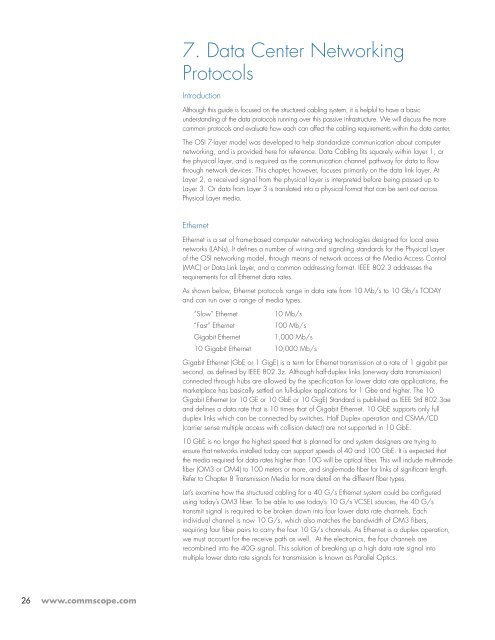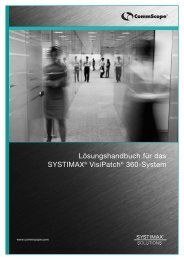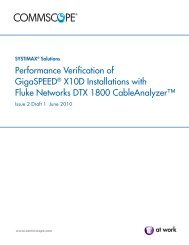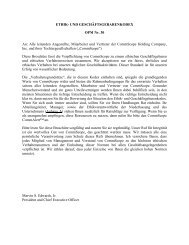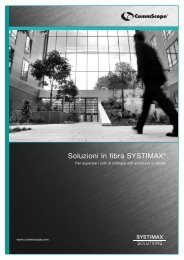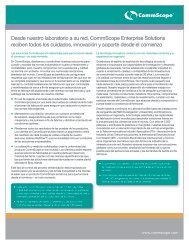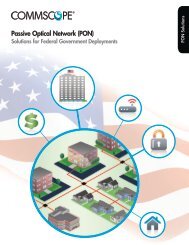CommScope® Enterprise Data Center Design Guide - Public ...
CommScope® Enterprise Data Center Design Guide - Public ...
CommScope® Enterprise Data Center Design Guide - Public ...
Create successful ePaper yourself
Turn your PDF publications into a flip-book with our unique Google optimized e-Paper software.
26<br />
www.commscope.com<br />
7. <strong>Data</strong> <strong>Center</strong> Networking<br />
Protocols<br />
Introduction<br />
Although this guide is focused on the structured cabling system, it is helpful to have a basic<br />
understanding of the data protocols running over this passive infrastructure. We will discuss the more<br />
common protocols and evaluate how each can affect the cabling requirements within the data center.<br />
The OSI 7-layer model was developed to help standardize communication about computer<br />
networking, and is provided here for reference. <strong>Data</strong> Cabling fits squarely within layer 1, or<br />
the physical layer, and is required as the communication channel pathway for data to flow<br />
through network devices. This chapter, however, focuses primarily on the data link layer. At<br />
Layer 2, a received signal from the physical layer is interpreted before being passed up to<br />
Layer 3. Or data from Layer 3 is translated into a physical format that can be sent out across<br />
Physical Layer media.<br />
Ethernet<br />
Ethernet is a set of frame-based computer networking technologies designed for local area<br />
networks (LANs). It defines a number of wiring and signaling standards for the Physical Layer<br />
of the OSI networking model, through means of network access at the Media Access Control<br />
(MAC) or <strong>Data</strong> Link Layer, and a common addressing format. IEEE 802.3 addresses the<br />
requirements for all Ethernet data rates.<br />
As shown below, Ethernet protocols range in data rate from 10 Mb/s to 10 Gb/s TODAY<br />
and can run over a range of media types.<br />
“Slow” Ethernet 10 Mb/s<br />
“Fast” Ethernet 100 Mb/s<br />
Gigabit Ethernet 1,000 Mb/s<br />
10 Gigabit Ethernet 10,000 Mb/s<br />
Gigabit Ethernet (GbE or 1 GigE) is a term for Ethernet transmission at a rate of 1 gigabit per<br />
second, as defined by IEEE 802.3z. Although half-duplex links (one-way data transmission)<br />
connected through hubs are allowed by the specification for lower data rate applications, the<br />
marketplace has basically settled on full-duplex applications for 1 Gbe and higher. The 10<br />
Gigabit Ethernet (or 10 GE or 10 GbE or 10 GigE) Standard is published as IEEE Std 802.3ae<br />
and defines a data rate that is 10 times that of Gigabit Ethernet. 10 GbE supports only full<br />
duplex links which can be connected by switches. Half Duplex operation and CSMA/CD<br />
(carrier sense multiple access with collision detect) are not supported in 10 GbE.<br />
10 GbE is no longer the highest speed that is planned for and system designers are trying to<br />
ensure that networks installed today can support speeds of 40 and 100 GbE. It is expected that<br />
the media required for data rates higher than 10G will be optical fiber. This will include multimode<br />
fiber (OM3 or OM4) to 100 meters or more, and single-mode fiber for links of significant length.<br />
Refer to Chapter 8 Transmission Media for more detail on the different fiber types.<br />
Let’s examine how the structured cabling for a 40 G/s Ethernet system could be configured<br />
using today’s OM3 fiber. To be able to use today’s 10 G/s VCSEL sources, the 40 G/s<br />
transmit signal is required to be broken down into four lower data rate channels. Each<br />
individual channel is now 10 G/s, which also matches the bandwidth of OM3 fibers,<br />
requiring four fiber pairs to carry the four 10 G/s channels. As Ethernet is a duplex operation,<br />
we must account for the receive path as well. At the electronics, the four channels are<br />
recombined into the 40G signal. This solution of breaking up a high data rate signal into<br />
multiple lower data rate signals for transmission is known as Parallel Optics.


